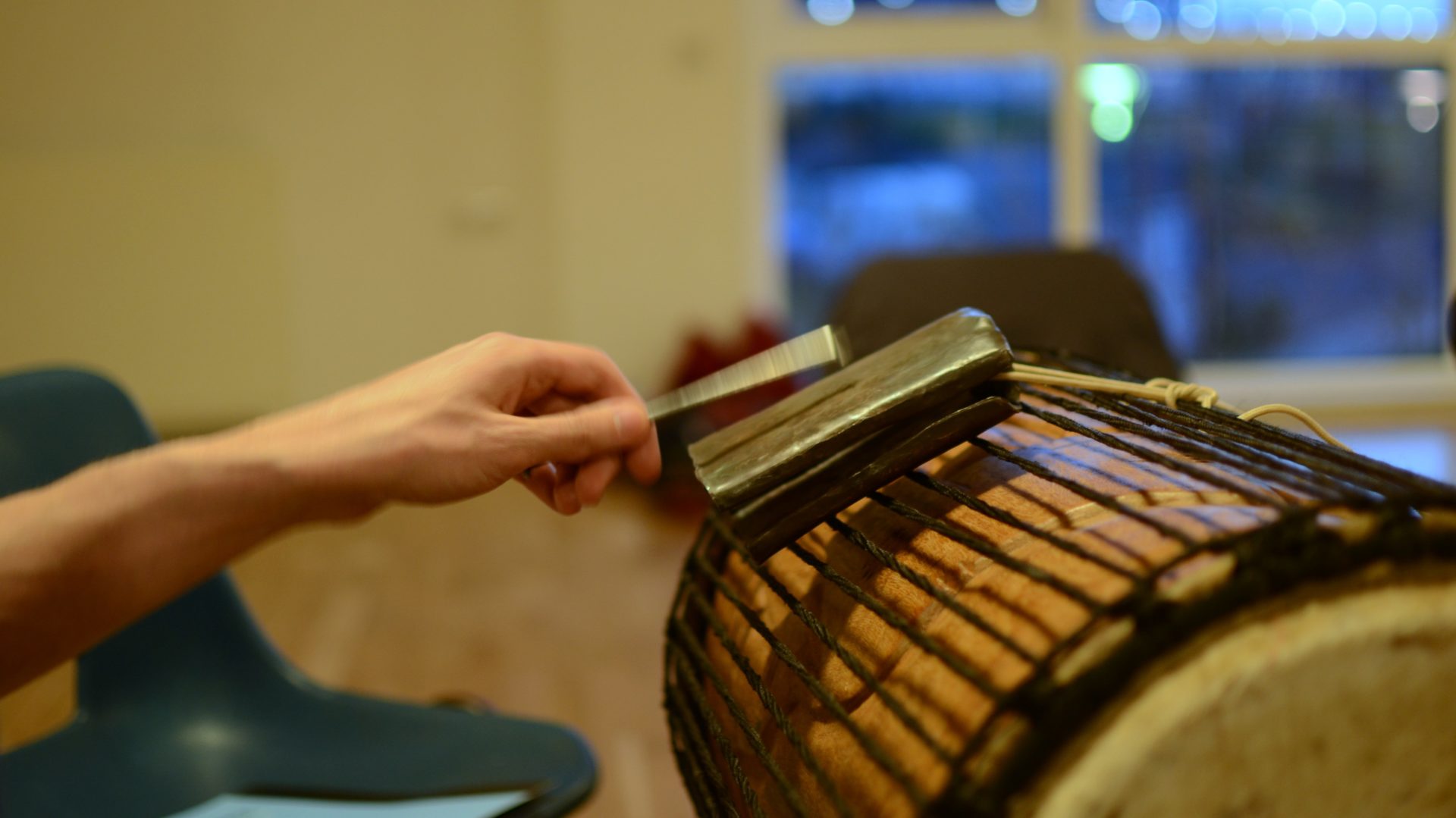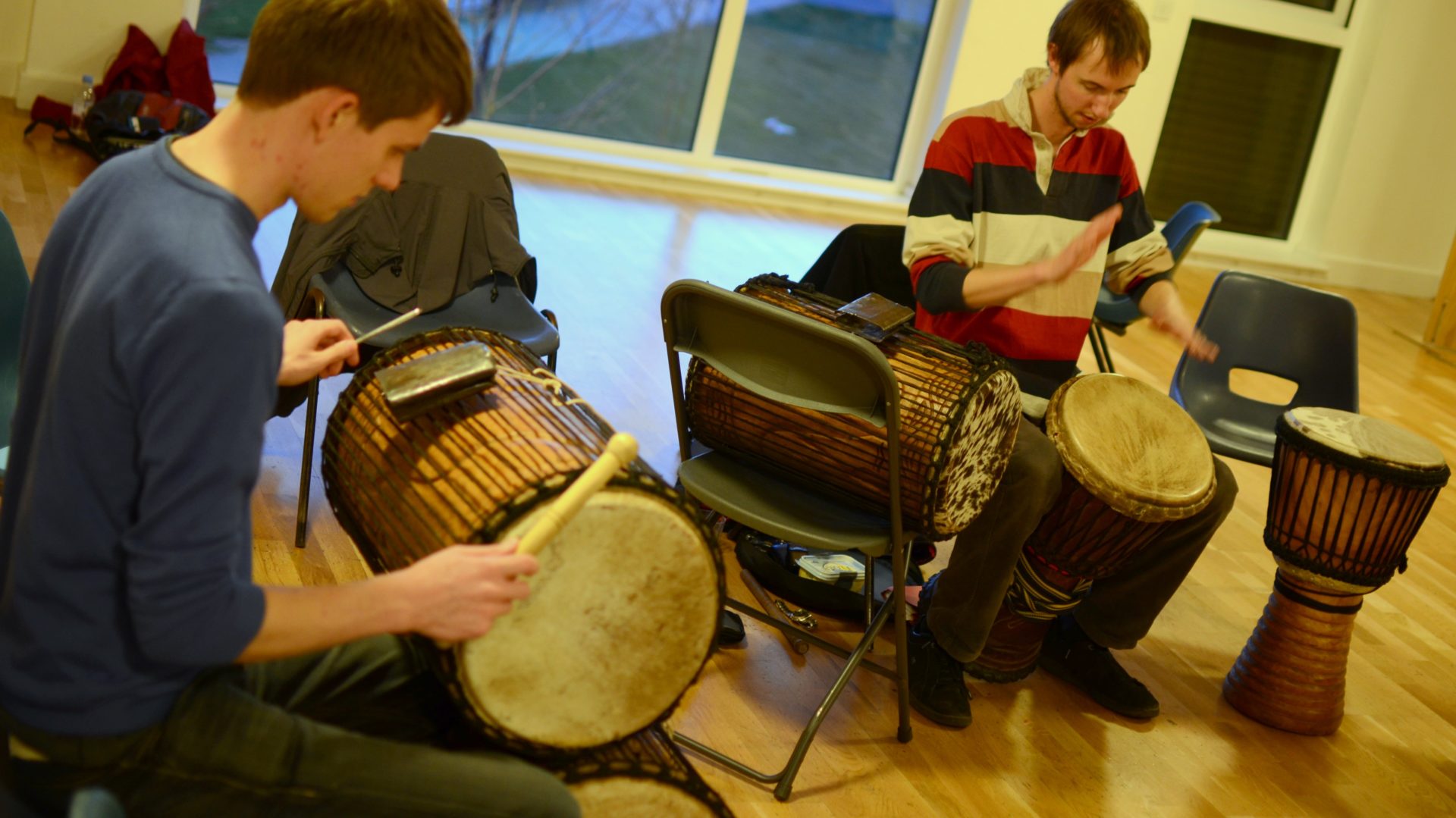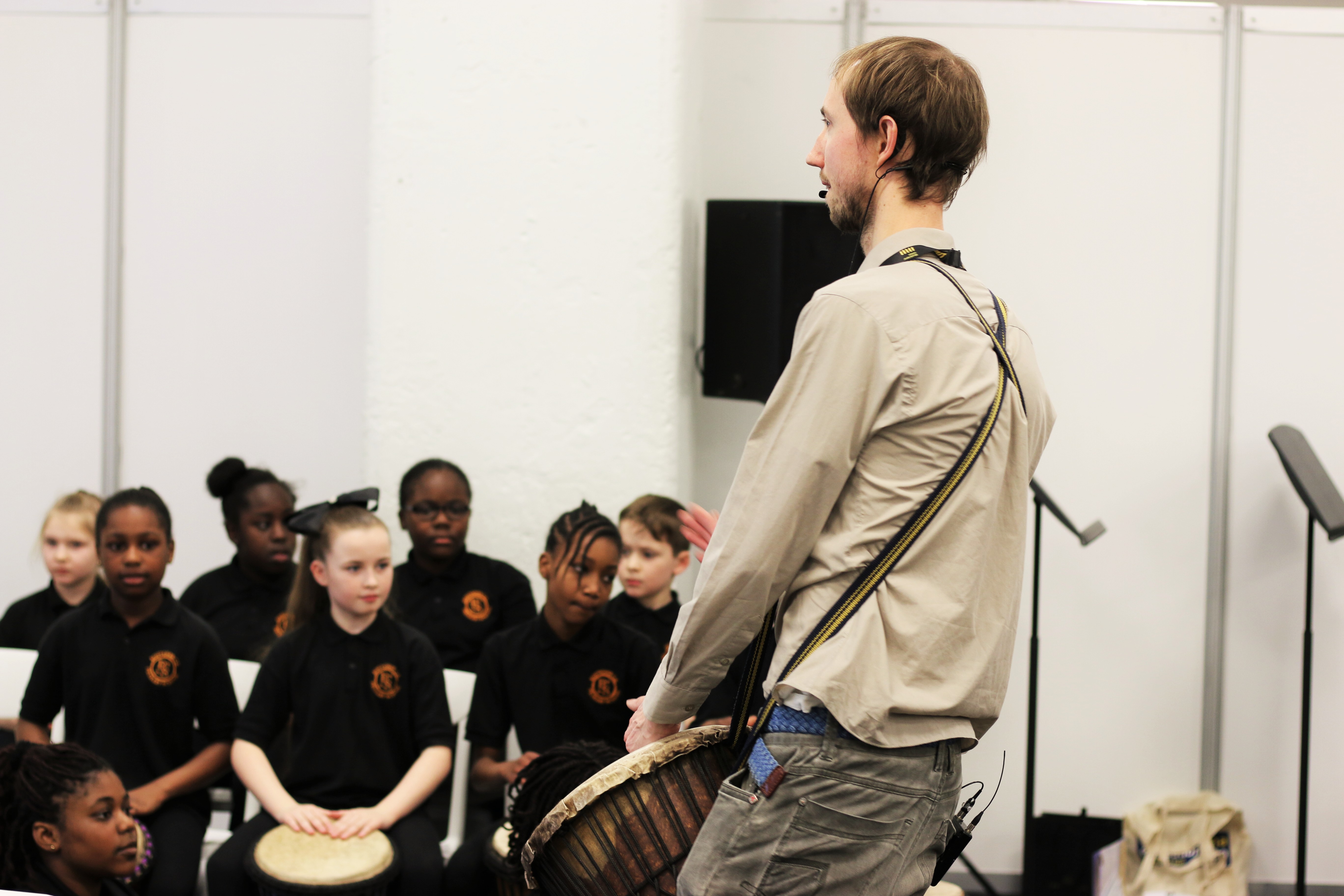An account on Laurence’s experiences in Senegal and Guinea in October 2011.
DAKAR-CONAKRY 29th September-6th October
My past week started glamorously in Dakar, waiting with a hoard of screaming fans at the aeroport for the arrival of the Senegalese ‘Katy Perry’ – Viviane N’Dour. An ensemble of 20 or more sabar drummers had assembled to salute her arrival, and Yatma, Viviane’s tama player, had the privalege of waiting alongside her black stretch-limo and a crowd of cameramen. When she finally emerged, the ‘Club Vivi’ fans entered a wild frenzy and we were soon running for our vehicle to join a mass convoy in pursuit of her limosine along with an assortment of motorbikes, vans, taxis and a giant party truck blasting out Viviane’s greatest hits from a mountainous PA system. Our vehicle pulled alongside her and as she waved from her window she recognised her musicians, Yatma and a fellow sabar percussionist, and truimphantly handed them one of the three trophy awards she had just brought back from the US. Yet in Africa even the most rich and successful are prone to mishaps, and her limo broke down on the main highway into Dakar. Preferring to avoid the embarassment of a mass push-start in front of a host of paparazzi, our humble ‘Ute’ had the honour of jump-starting her limosine. The glamour!
My remaining few days in Dakar included the usual routine of lessons, studio recording, rehearsals and performances. I said goodbye to my wonderful hosts Yatma, Amina, Papy and Falu (all other inhabitants were in bed) on Monday morning and headed east for Tambacounda. The journey, in a cramped ‘sept-place’ taxi, was 10 hour slog (two hours longer than my guidebook estimated), with the aid of two reserve cabs after our first broke down on the outskirts of Kaolack. However, this pailed into insignficance compared to events the following day.
I woke up early for a sept-place to Diaoube, the ‘gateway to Guinea’. To my surprise we arrived after a comfortable 2 and a half hours. Buoyed by this success, in a somewhat rash moment, I impulsively accepted the offer of a sept-place all the way to Conakry. When I asked ‘when will we arrive’, all I got in reply was ‘tomorrow’. We left at 11:30am, so I reasoned that I would be saving money on a night’s stay in a hotel by sleeping in the taxi, and would arrive in daylight the next day in Conakry – perfect.
Neither of these things happened. As our impending departure was announced, a seemingly endless stream of people boarded our clapped out Peugeot estate – this was no sept-place: this was an ‘onze-place’! 2 in the front, 4 in the middle and 3 adults and 2 children in the back. What’s more, I had the pleasure of sitting on the metal bar that separated the middle seats – this was gonna be a comfortable ride!
The journey was a gruelling 33 hours and included: 6 road barrages to check VISAs, passports and ID cards; a 3-hour stoppage in the north Guineen forest as two Peugeots ahead of us had got stuck in the thick mud (still the wet season here in Guinee); and a crash into a bridge which left our car hanging precariously over a 6ft drop. In addition to all of this I was vomited on by one of the small children behind.
And so it was – I arrived in Conakry, in the darkness, at 7:30pm the next day having got 1-hour’s-worth of light sleep, to meet my new host and teacher, Lamin. On the short taxi ride to his place we conversed comfortably in French and English – un peu.
DJEMBEFOLA 6th October-13th October
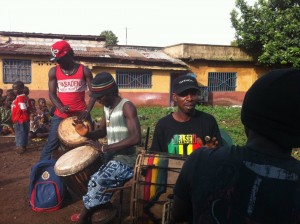
On my first full day in Conakry I managed to persuade Lamin to give me my first djembe lesson. He taught me a dance from his family’s hometown of Boke called Nmadjaba. The lesson entailed endless repetition of the 3 supporting rhythms: 1st, 2nd and bass, and then finally the masterdrum part. This was a sign of things to come as the next day, my second teacher arrived, Soda. With Lamin and Soda I’ve been learning 2 hours a day, and in a weeks work I’ve learnt 3 dances. This is old fashioned learning by rote, as I endlessly cycle Nmadjaba, Tiriba and Dundunba. I’m gradually getting more attuned to the swing and syncopation of my accompaniment parts, Lamin’s dundun parts and Soda’s solo drum. Dundunba in particular has an especially confusing lilt, but the key is familiarisation, and for two hours a day I am certainly becoming familiar with it.
Our week began in the capital, Conakry, but shortly after Soda’s arrival from Boke I was told that we must head north and learn in the village. We departed after a weekend watching and performing in a l’excision ceremony, involving a djembe group of 3 dunduns, 3 supporting drums and a solo djembe – guitar and a singer with an incredibly loud, distorted and reverberant PA system. The latter somewhat spoilt the whole musical experience for me, as it rendered the drums almost inaudibly obsolete.
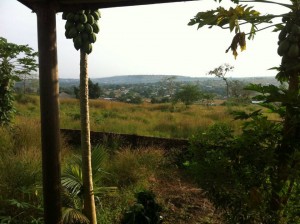
Boke, however, is a very different experience. Soda lives in a house 10 minutes moto-ride from Boke town centre. With no electricity, we rise early and sleep shortly after nightfall. It’s a very chilled existence, enhanced by the relaxed rasta lifestyle that my teachers lead. Yet for 2 hours a day it’s hard graft here!
Nmadjaba – djembe music and dance from Boke, traditionally played by the Djakanke tribe at village ceremonies
Tiriba – also ceremonial dance from Boke, originates from Landuma tribe
Dundunba – genre of music and dance belonging to the Malinke tribe, the rhythms I learnt originated from Kouroussa
l’excision – ceremony for young girls aged 6-12 as they undergo circumcision. Female genital mutilation is illegal in Guinee, yet it is a deeply held tradition and an estimated 98% of Guineen women still undergo the procedure
PARADISE ISLAND 13th October-20th October
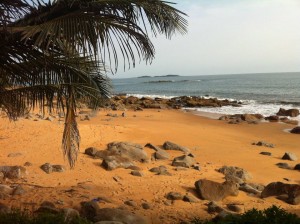
We headed back to the capital on Sunday, at considerable expense (carrying with us 4 djembes, 2 dunduns and our rucksacks), a mere 4 and a half hour bush-taxi ride, to be cheerily greeted by old friends from the week before. The immediate neighbourhood seemed pleased to have their unusual looking fote friend back. Our return was principally down to the imminent arrival of my English friend Simon, who was coming to join us for 3 weeks, at Conakry Airport on Monday night… or so I thought as I went to bed on Sunday night.
I was awoken at 2am by Soda (mon premier professeur) saying something confusing in French about my friend. As I gradually came to, I realised that he trying to tell me that my friend had arrived at the airport TODAY and was awaiting us at the pick-up zone. Overcome with guilt, I hastily got dressed and walked along the deserted high road with Soda and Lamin in search a taxi. We non-negotiated a costly fare and rapidly made our way to the airport – thankfully just a 10-minute drive away. Simon was standing slightly sheepishly with a friendly hustler from Sierra Leone, who had used his local knowledge and good English to establish that the ‘address’ I had given to Simon was in actual fact Lamin’s phone number – and had rung to alert us of his arrival. We greeted them both and thanked ‘Aruna’ for his help – before a relieved taxi ride home. We decided to depart without delay for Ile Room the following day.
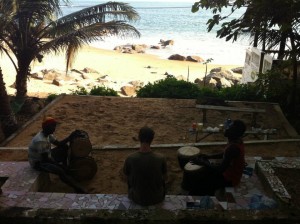
Having negotiated hard at Port de Boulbinet in Conakry, the four of us, with djembes and dunduns, boarded a pirogue bound for the isle. The chaos of the metropolis faded away behind us as we arrived on an island no bigger than two miles across and populated by roughly 200 locals – and 3 hotels. Palm trees, exotic wildlife (an assortment of giant snails, millipedes, frogs, lizards and snakes), beautiful deserted beaches and hammocks to lounge in – this was paradise island.
Between trips to the only village for food (hotel meals were, understandably, extortionately priced), Simon and I had our respective lessons, 2 hours each, and swam in the ocean twice a day. One evening we stopped off in the village night spot ‘Africa Night Bar’, which served warm soft drinks and normally hosted the island rastas. With the benefit of Simon’s abnormally powerful torchlight – no electricity here – some musicians arrived to play for us. It was touching that Simon and I represented the entire island’s tourist industry (which peaks in December) and thus that the musicians had assembled to entertain us with the hope of some financial reward. The group, named ‘Soleil de Room’, were made up of traditional Guineen instruments: the bolon, gonee, balafon, krin, cassi and gongorma. The resulting sound was beautiful, with effortless musicality and a strong folkloric spirit, enhanced by the sonorous lead refrains of our hotel manager, Senna, and the hearty responses of the band. Each song seemed to tell a story, and was often addressed directly to a person present, with a melancholic tone. We donned them a generous 25,000 Guineen francs (about three pounds) in return for an unforgettable night and made our way back, under a blanket of stars, to our modest hotel – in which we were the only guests.
fote – Sousou word for ‘white’ i.e. white man; Sousou is a widely spoken language along the coastal region of Guinee
Bolon – an ‘upright’ three or four-stringed bass with a goat-skin covered calabash body, the player strikes the strings and the body for a percussive sound
Gonee – plucked like a kora (or harp), the one I saw had eleven strings (a kora has 21), also with a calabash body
Balafon – West African pentatonic xylophone with gourd resonators that rattle like a snare
Krin – a hollow wooden cylinder stuck in the middle with sticks to make two resonant pitches and on the edge for a shell-like sound (its a real instrument version of the pointless classroom wooden box!)
Cassi – (also called rattles, cascanets, caxixi) woven pyramid-shaped basket shakers, shaken vertically so that the beads inside strike the hard surface at the base
Gongoma – (also called mbira, kalimba, thumb piano) half a calabash and wood forms the body, while the player plucks three or four thin metal ‘keys’
ADAM, JOE AND THE RASTAS OF BOKET 20th October-3rd November
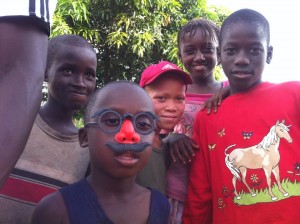
We left the beautiful Ile Room early on Friday, and after a brief stop over for a l’excision ceremony in Conakry, we headed straight for our professeurs’ hometown of Boke once more on Sunday. The routine went much as before, only this time it felt slightly more like a holiday with the company of my English friend Simon. It was certainly nice to share some British humour, and also to engage in some Western pleasures in the form of Simon’s iphone, and more specifically the sounds of Adam and Joe‘s grossly out of date XFM podcasts. These provided the soundtrack to bedtime (generally around 21h30) while the drumming of Boke’s ballet company ‘Batafon’ and Soda’s percussion group provided the audio entertainment in the afternoons.
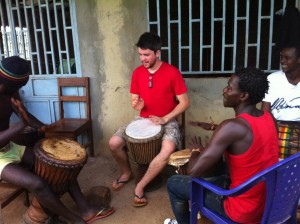
Soda’s group in particular were astonishing to watch. The physicality of djembe music here is clearly evident as the sweat pours from each arm-flailing player – flailing ever faster as the solo djembefola pushes the tempo with his chauffement and eventually calls for a drum break. Soda’s group, all rastafarians (not sure if all musicians in Guinee are rasta, but all of the ones I’ve met have been!), includes three dundun players: kenkeni (without a bell), sangban and dundunba (positioned on opposing sides of the two stacked drums and sharing one bell); bass djembe (a close relative of the dunduns, helping drive the music), 2 supporting djembefolas, and 4 soloist drummers who share out soloing duties and play additional accompaniment patterns. The extended drum breaks are particularly exciting to watch as, with no dancers, this percussion group show off their virtuosity with great panache.
The ballet troupe, Batafon, who rehearse in the same cavernous community centre, used a different drum line-up: kenkeni (with bell), one dundun player playing 3 vertically mounted dunduns, 2 supporting djembes and a soloist. At times, while watching the dancers jump around the stage demonstrating their athleticism and grace, it felt more like I was watching an acrobatics group.
A thoroughly pleasurable week-and-a-half passed in which we made many rastafarian friends, one named Drogba (for obvious reasons), one named Fote (Sousou word for white – he is lighter skinned than the average Guineen), and the most senior of all, a carpenter called Ali Bonde, whom we referred to as “Rasta-Kev”, as his ability to hold an audience with his stories reminded us of our old Trinity percussion teacher, Kev Nutty.
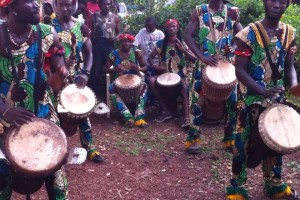
As our departure drew near, Soda organised a performance from his group followed by a ‘dundunba’ in the street in our honour, to which we invited all the local artists. It was a fantastic send off, and gave Simon and I a great opportunity to see all that we had learned put in to context. Then it was time to head back to Conakry for Simon’s flight back to Angleterre (we’d triple checked the time to avoid any further fiascos), and nearly time for me to say farewell to Guinee!
Batafon – name of the ballet company in Boke taken from the local river. One Sunday this caused great confusion as Simon and I headed out with Soda and Lamin thinking we were heading for a ballet rehearsal… when we pulled up on the motorbikes on the banks of a huge great river, Simon exclaimed ‘We’ll never make it across there!’ We eventually got the message and had a good old swim in our pants!

